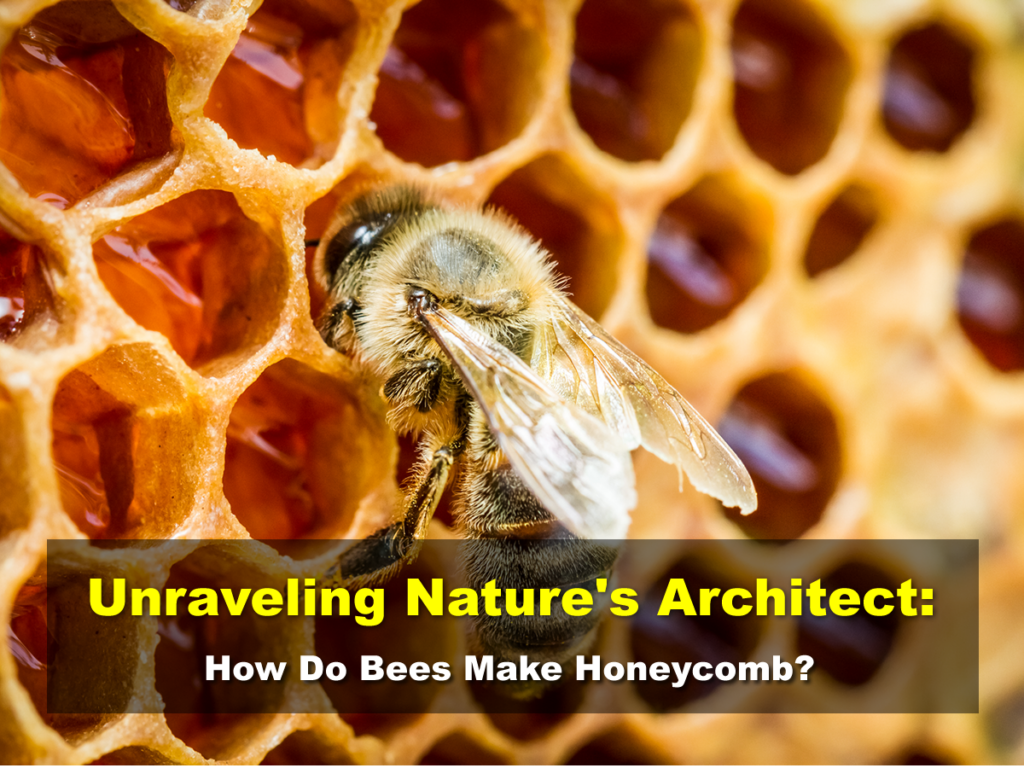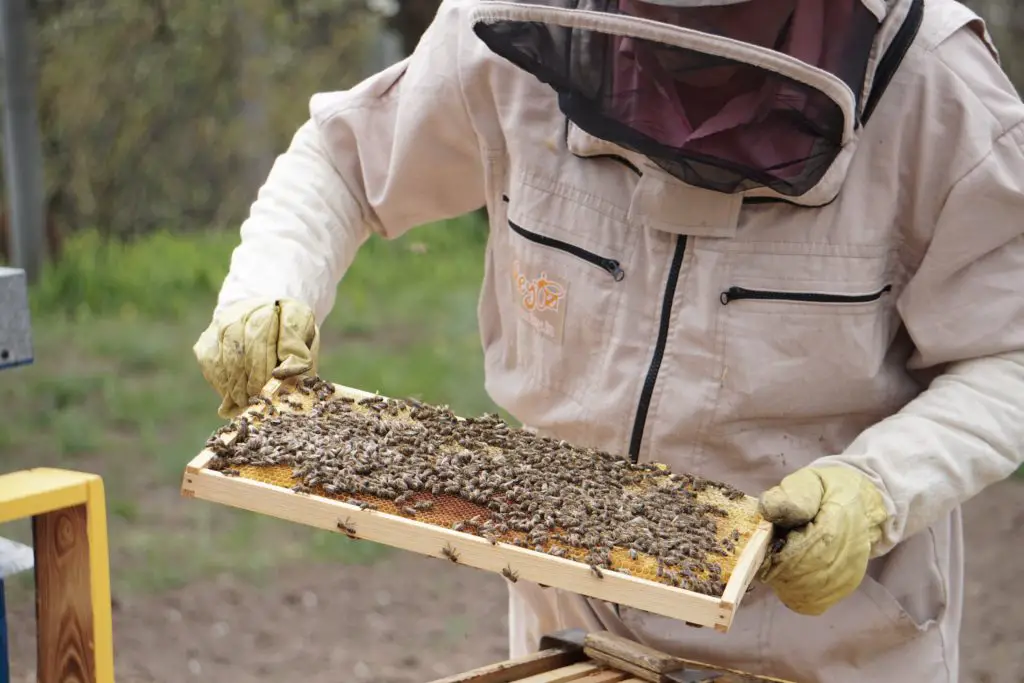Affiliate Disclaimer - As an Amazon Associate I earn from qualifying purchases.
It supports the website. So, Thank you
A beehive is a hub of activity and these hardworking insects are always on the go. When they’re not making honey, there are other things to be crafted within the hive and one of those things is honeycomb. But how do bees make honeycomb and why is it so important?
Bees make comb from wax which is made by the wax glands in the abdomen of the worker honey bee.
Of course, there’s a lot more to this amazing process and, if you’re keen to find out more, I’ll discuss everything you need to know in this guide. Let’s get started!
Honeycomb: One Of Nature’s Wonders
It’s possible to buy honeycomb as a tasty, sweet snack and this is a confection that combines honey and beeswax. However, when we look at the honeycomb within the hive, it’s made from wax which is another substance produced by bees. One of the things that never ceases to amaze me is the sheer amount of work that a bee needs to do in order to produce just one ounce of wax.
To make that single ounce of wax, the bee must consume around eight ounces of honey. To produce an ounce of honey, bees need to pollinate 125,000 flowers. So, if they’re looking to consume eight ounces, this means they would have to go to around 1 million flowers! It’s a good job then that colony numbers are in the tens of thousands and that bees are such team players!
So, once the bees have consumed enough honey, it’s time to start making the wax. Interestingly, bees only produce wax when they are between 10 and 20 days old and they do this with wax glands which are located on the underside of their abdomen.
These glands ooze wax and it comes out in little scales that are no more than half a millimeter deep and around 3 mm in length. When the wax is secreted, the worker bee can then scrape it off her body. She does this thanks to little spines along the pollen baskets on her hind legs before moving the wax to her front legs to work it.
In order to make it as malleable as possible, the worker bee will mix the wax with saliva and will then get to work chewing it. She can now shape it into a comb and this process is done over and over again to create the overall structure of the comb you see in your hive.
Why Are Honeycomb Cells Hexagonal?
Isn’t it strange that, no matter where you are in the world, if you look at honeycomb, it always has the same shape? Bees are fascinating creatures that live a life guided by routine and structure and the way that they made their honeycomb cells is no exception to this rule.
Honeycomb cells are always hexagonal in shape but over the years, there have been lots of arguments as to why this is. Many people believe that it all comes down to evolution and how bees have adapted over the years while other people simply think it is because bees are such smart creatures. But if you think about it, there could be another explanation and it’s all to do with the science of physics.
Making cells in a hexagonal shape doesn’t appear to just be by chance; this shape actually has a variety of advantages. Some would agree that one of the reasons for the shape is down to the fact that a hexagon leaves no room for gaps where a circle might. However, the same could be said for other straight-sided geometric shapes like the triangle of square so this probably isn’t the main reason.
That said, think about the hexagon compared to other straight-sided shapes and you’ll quickly see that the hexagon uses the least amount of wax per shape. This is actually a notion that has been up for debate for a very long time, causing conflict among scientists. However, it was all put to rest after a guy named Thoman Hales, from the University of Michigan, performed some research to prove that hexagons were the most efficient shape to produce.
It’s also worth considering that having a set of hexagonal shapes allows for efficiency and uniformity. Imagine building a honeycomb with cells that only come in random shapes. It would be perfectly possible to connect all the shapes to one another by making subsequent shapes fit the previous one. However, this would mean that the bees could not create shapes until the previous one had been finished.
Since bees work as a team, there may be several individuals making honeycomb cells at any given point. If they were all random shapes, the chances of them fitting together uniformly would be incredibly low. But with all bees making the same hexagonal shape, they can produce several cells at the same time, safe in the knowledge that everything will fit perfectly together. The result is greater speed and efficiency when it comes to building.
What Is The Purpose Of Honeycomb?
Now that we understand how honeycomb is produced and why it’s made the way it is, the next question is what’s the point in it all? Well, you don’t need me to tell you that bees produce honey but they produce so much that they need somewhere to store it. That’s where Honeycomb comes to the rescue.
Bees are summer insects; they simply do not perform as well in cold, wet weather so over the winter, they go into a state similar to hibernation known as torpor. This is not a full-on sleep as we see in some animals but is a dormant or resting state. The bees huddle together and remain in the hive where it is warm and safe.
However, they aren’t going to survive the winter without a food source and that’s why they work so hard over the summer to produce a good amount of honey. This is then stored within capped honeycomb cells for the bees to use once winter sets in.
In order to prepare their winter food source, the bees will go out and gather nectar which is then put into uncapped cells for evaporation. In order to speed things up, the bees will use their wings to fan the nectar, helping to remove water and gradually turning it into honey.
At this point, it’s time for the bees to cap the honeycomb cells which they do by adding a layer of wax over the opening of the cell. With the wax in place, the water content of the honey will remain consistent and ready for the bees to eat.

However, honey isn’t the only thing that bees need in their diet. It’s a brilliant source of carbs but in order to get fats and protein, these beautiful little creatures will also feed on pollen. This is a powdery substance found in plants and is what they use to reproduce. If you observe bees, you’ll often see them covered in pollen as they bring it back to their hive. It’s one of the most rewarding parts of taking care of honey bees.
Unlike when they collect nectar, bees will take their foraged pollen directly to a honeycomb cell and store it themselves. With nectar, worker bees returning to the hive will pass the nectar onto other bees who will then process and store it.
The way that bees communicate is one of the most fascinating things about these creatures. It’s incredible how effectively they can ‘talk’ to one another and the honeycomb they create plays an important role in this.
When bees communicate, they largely use their senses and they’re well known for their pheromone communication which essentially means they have to rely on their sense of smell. Bees will emit certain pheromones depending on what they’re trying to communicate and other members of the colony will pick up on the scent.
They’ll also use vibrations and the honeycomb acts as the basis for this. It’s not actually one of the most obvious forms of bee communication but it’s an important one. By sending vibrations through the comb, bees are able to communicate messages to others within the colony.
But food storage isn’t the only reason that honeycomb is an essential structure within the hive; bees also use it for rearing their young. When the queen lays her eggs, she does so within the cells of the comb. Each comb will contain one egg which will eventually hatch into a wriggling white larva.
Honeycomb Cells For Different Bee Castes
What is truly fascinating about the way that bees use their honeycomb is they seem to know which cells are suitable for which types of bees. There are three main types of bees within a colony; the queen, the workers, and the drones.
Queen bees are there solely to reproduce and will spend their lives laying eggs and ensuring the survival of the hive. While there can only be one queen at a time, new queens are constantly being raised by feeding royal jelly to specially chosen larvae.
When eggs are laid that stand a chance of becoming a queen, they are laid in cells called queen cups. When you compare these to other cells, it’s very obvious that they have a totally different shape and size. Instead of the regular hexagonal design, these cells look more like a peanut and they hang from other parts of the comb.
If the eggs laid are destined to turn into drones or male bees, then they need a slightly larger cell because the larvae will be bigger. What’s more, bees even cap the cells with a differently shaped piece of wax that is more domed compared to the cells of worker bees. This demonstrates how intelligent bees are as it’s a way for them to differentiate between the eggs in each cell.
However, the majority of the honeycomb cells used for raising eggs belong to worker bees or females. These are not as large as the drones of queens so the cells are much smaller.
Final Thoughts
Take a look into the hive and you will notice the beautiful structure that is honeycomb. This is something that the bees use for raising their young and storing food but many people wonder how bees make honeycomb.
As with everything in the hive, honeycomb is made with natural materials that are produced by the bees. Bees collect nectar and turn this into honey which can then be converted into wax and formed into comb cells. It’s just one of the many ways that bees show us just how self-sufficient they really are!




